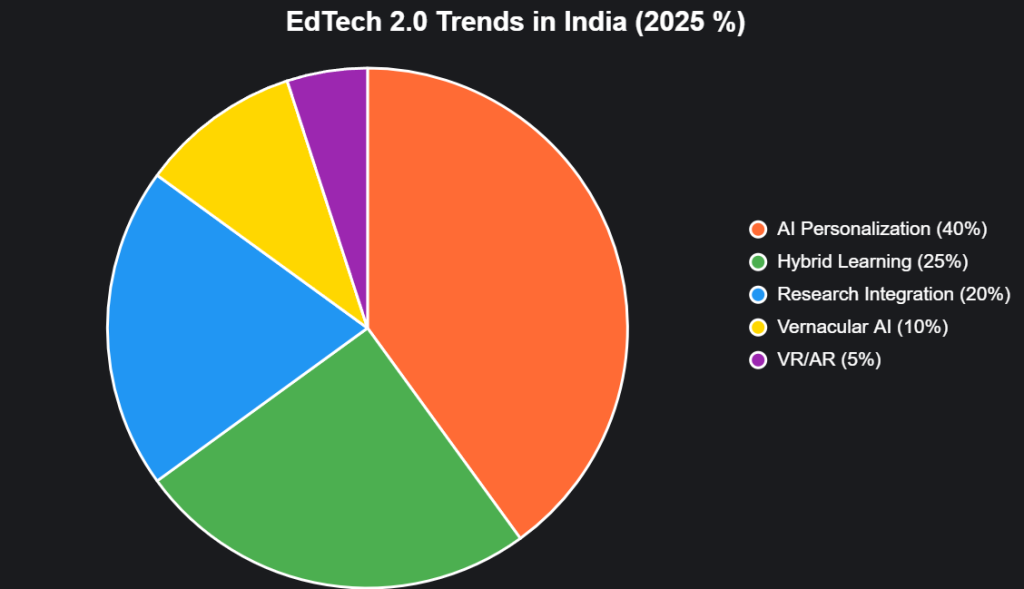India’s EdTech sector, once synonymous with pandemic-era online classes, is undergoing a profound metamorphosis, evolving into “EdTech 2.0” – a research-driven, AI-centric powerhouse projected to reach $10.4 billion by 2025, up from $7.5 billion in 2024, with a 38.1% CAGR fueled by adaptive learning and upskilling demands.
As NEP 2020 mandates AI integration from high school by 2025 and 96% professionals seek AI readiness, startups like Physics Wallah (10M users, $210M raised) and UpGrad (107% GenAI enrollment surge) are shifting from video lectures to AI tutors, vernacular LLMs, and research-embedded curricula, unlocking talent in differential paths and boosting test scores 62%. With 71% students preferring hybrid models and platforms like Amira Learning personalizing for 67% effectiveness gains, EdTech 2.0 isn’t just scaling access
—it’s redefining learning equity for 250 million students. Backed by AICTE’s “Year of AI” and Coursera’s partnerships with 18 IITs/IIMs (2.6M GenAI enrollments), this wave promises to bridge rural-urban divides, with 75% rural adoption via affordable data and vernacular AI. As X educators proclaim, “AI + EdTech = India’s learning supernova,” this evolution from screens to smarter futures could add $225 billion to the sector by 2030. Dive in, or be left lecturing the past.
Table of Contents
EdTech 2.0: From Passive Videos to Active Intelligence
The pandemic catalyzed EdTech’s first wave—$568 million in 2024 funding across 29 deals, up from $283 million in 2023—but 2025 marks maturity, with AI personalization and research integration at the core. NEP’s push for AI coursework from high school, alongside Digital India’s 59% internet penetration, drives hybrid models (71% preference) and VR/AR classrooms, per Grand View Research. Platforms like Khan Academy’s Khanmigo and BYJU’S/Embibe offer adaptive paths, with 62% score boosts and 107% GenAI enrollments on Coursera (2.6M, highest globally). X: “EdTech 2.0: AI tutors > rote learning—India’s 2025 edge.”
This pie chart illustrates EdTech 2.0 trends (2025):

Source: EY, Grand View. AI leads, unlocking unrealized potential.
Key Pillars: AI Research and Beyond Classes
1. AI-Driven Adaptive Learning
AI analyzes performance for personalized paths, with tools like Amira boosting 62% scores and 67% effectiveness. Emeritus’ 20+ ML courses saw 3x enrollments, 75% from 10+ year pros.
2. Research-Embedded Curricula
NEP integrates AI from high school, with IITs/IIMs partnering Coursera for GenAI skills (107% rise). Bosch Survey: 96% Indians seek AI upskilling.
3. Vernacular and Inclusive Tools
75% rural adoption via affordable data and regional AI, per EdTech Review. Platforms like Prakash offer customized vernacular upskilling.
| Pillar | Key Trend | Impact |
|---|---|---|
| Adaptive AI | Personalized paths | 62% score boost |
| Research Integration | NEP AI courses | 107% GenAI enrollments |
| Vernacular Tools | Regional languages | 75% rural adoption |
Source: TeachBetter, EY.
Challenges: Scaling the 2.0 Vision
Data privacy (PDP Bill) and 32.2 million out-of-school children (UDISE+ 2023-24) loom, with dropout rates at 23% by Grade 10. X: “AI EdTech: Promise vs. privacy pitfalls.”
The 2.0 Ascent: $30 Billion by 2030
EdTech 2.0 could hit $30 billion by 2030, per Inc42. Founders: Innovate inclusively. India’s beyond classes—it’s coding the future. Leap in, or lecture from the sidelines.
social media : Facebook | Linkedin |